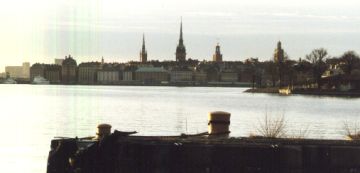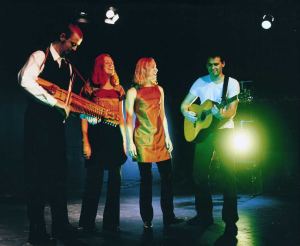FolkWorld article by Michael Moll:
The Swedes do it differently
Scanfolk Part III: Moving on to Sweden. Folk Music educations, concerts
and dance, a lot of great music...
 Stockholm is a very special town - also folk music wise. Having
been in Stockholm now for more than two months, Michael Moll is trying to explain
what makes the whole Stockholm, and also the Swedish, folk music scene special,
setting it apart from most other countries' scenes.
Stockholm is a very special town - also folk music wise. Having
been in Stockholm now for more than two months, Michael Moll is trying to explain
what makes the whole Stockholm, and also the Swedish, folk music scene special,
setting it apart from most other countries' scenes.
The first concert I visited after having come over took place in Stockholm's
newest and at the same time best folk music venue: The Stallet. Owned and run
by the RFoD, Sweden's national folk music organisation financed by the state,
the Stallet has the aim to present the best of Swedish and international folk
music and dance bands, becoming the main stage for traditional folk music and
dance.
 This very concert was the graduation concert of a folk music student of the
Royal Music Academie in Stockholm, the fiddler Hadrian Pratt. Mastering most
of the concert on his own, with at times the addition of another fiddler, the
surprise was when he came up with a very modern piece, with programming, drums
etc. giving a totally different perspective to this musician.
This very concert was the graduation concert of a folk music student of the
Royal Music Academie in Stockholm, the fiddler Hadrian Pratt. Mastering most
of the concert on his own, with at times the addition of another fiddler, the
surprise was when he came up with a very modern piece, with programming, drums
etc. giving a totally different perspective to this musician.
The Royal Academie, offering since about 10 years folk music courses, has become
a breeding ground not only for new traditional bands, but also for fusion bands
with influences in rock, jazz, classic. Although the education is basically
on traditional music, the Academy provides the possibility to meet up with the
students of other music styles. It is quite obvious that the introduction of
folk music courses has brought a very fresh wind into the Stockholm folk scene,
not only regarding new exciting young bands, but also as these students are
frequent visitors to concerts and dances, decreasing considerably the average
age of the visitors.
A lot of the concerts I have seen up to now were in some ways related to the
Academie. One of the most exciting ones was actually the surprise evening concert
of students of the Academie, showing how much talent there is around, and how
innovative these musicians are. The concert provided both very traditional fiddle
music and modern influenced roots music, like a duo playing polskas on sopran
and tenor saxophone. Those music students are in no way the "typical"
alternative folkie; they present a very trendy image of the folk music scene.
Which is a real joy to see.
 Another special feature of the Stockholm scene is that concert and dance scene
are closely linked to one another. Most concerts in the Stallet, as well as
in the Folkmusikhuset, combine a first half concert, with the audience having
the possibility to just enjoy the music itself, with a second half a dance concert,
where the chairs are put away, and the dance floor is open to all who want to
dance. A bit of a surprise for me!
Another special feature of the Stockholm scene is that concert and dance scene
are closely linked to one another. Most concerts in the Stallet, as well as
in the Folkmusikhuset, combine a first half concert, with the audience having
the possibility to just enjoy the music itself, with a second half a dance concert,
where the chairs are put away, and the dance floor is open to all who want to
dance. A bit of a surprise for me!
Among the concerts I saw at the Stallet, there was also the CD release concert
of the Finnish accordenist Maria Kalaniemi and the Swedish fiddler Sven Ahlbäck,
joined by nyckelharpa player Johan Hedin and singer Susanne Rosenberg. This
has been a wonderful concert, showing the full range of talent of these musicians,
and linking Swedish and Finnish music traditions. Hopefully more live appearances
will follow! For those of you who were not there, I can fully recommend the
CD (see review section of FolkWorld!).
Swåp, the English-Swedish collaboration between Ian Carr and Karen Tweed,
and Carina Normansson and Ola Backström, had an appearance, them playing
also half the concert for dance. Ranarim were one of the representants of newly
formed Swedish bands linked to the Royal Academie - to find out more about this
magnificent band read the article about them!
 The concert "Mästarmöte" presented loads of female traditional
fiddlers, all masters (as the title says), both young and older. Lena Willemark
put this concert together. Providing more than 2 hours of just fiddle music,
and mainly Polskas, partly solo, partly as fiddle duo, this was a special concert,
although it became with the time a bit tiring to hear only fiddles, without
any accompaniment. Yet it was a strong proof that the fiddle tradition in Sweden
is in safe hands, as five of the ten fiddle masters presented in this concert
looked like still being well under 30 years.
The concert "Mästarmöte" presented loads of female traditional
fiddlers, all masters (as the title says), both young and older. Lena Willemark
put this concert together. Providing more than 2 hours of just fiddle music,
and mainly Polskas, partly solo, partly as fiddle duo, this was a special concert,
although it became with the time a bit tiring to hear only fiddles, without
any accompaniment. Yet it was a strong proof that the fiddle tradition in Sweden
is in safe hands, as five of the ten fiddle masters presented in this concert
looked like still being well under 30 years.
There is definitely a lot to discover on the Swedish scene right now; the amount
of high quality CDs released in the last years is another proof of this.
The Swedish scene has some more mysteries which are astonishing for a German
folky. One of these things is the strong financial support the Swedish state
is giving to folk music, in particular to Folk Music recordings. But probably
I should leave some stuff for Scanfolk's No. 4.
Further Reading and Info on the Swedish Folk Music Scene:
- (FolkWorld) Ranarim - interview with one of the
exciting new young bands, featuring quite a few facts on the Swedish scene.
- (FolkWorld) FolkWorld CD Reviews - this issue with
quite a few Swedish releases.
- www.stallet.st, the website of
Stockholm's premier venue for Folkmusic, the Stallet.
- come.to/folkmusikhuset/; Folkmusikhuset
at Stockholm's Skeppsholmen islands offers every Sunday free dance evening,
along with music and singing sessions. Additionally, they organise regular
concert/dance evenings.
The first two parts of the Scanfolk series were featuring Denmark:
Photo Credit: Photos (exept 4 - press photo) by the Mollis: (1) Stockholm, (2) Sweden in winter, (3) Swåp, (4) Ranarim
Back to the content of FolkWorld
Articles, Live Reviews & Columns
To the content of FolkWorld
online magazine Nr. 18
© The Mollis - Editors
of FolkWorld; Published 4/2001
All material published in FolkWorld is © The Author via FolkWorld. Storage for private use is allowed and welcome. Reviews and extracts of up to 200 words may be freely quoted and reproduced, if source and author are acknowledged. For any other reproduction please ask the Editors for permission.
FolkWorld - Home of European Music

Layout & Idea of FolkWorld © The Mollis - Editors of FolkWorld
 Stockholm is a very special town - also folk music wise. Having
been in Stockholm now for more than two months, Michael Moll is trying to explain
what makes the whole Stockholm, and also the Swedish, folk music scene special,
setting it apart from most other countries' scenes.
Stockholm is a very special town - also folk music wise. Having
been in Stockholm now for more than two months, Michael Moll is trying to explain
what makes the whole Stockholm, and also the Swedish, folk music scene special,
setting it apart from most other countries' scenes. This very concert was the graduation concert of a folk music student of the
Royal Music Academie in Stockholm, the fiddler Hadrian Pratt. Mastering most
of the concert on his own, with at times the addition of another fiddler, the
surprise was when he came up with a very modern piece, with programming, drums
etc. giving a totally different perspective to this musician.
This very concert was the graduation concert of a folk music student of the
Royal Music Academie in Stockholm, the fiddler Hadrian Pratt. Mastering most
of the concert on his own, with at times the addition of another fiddler, the
surprise was when he came up with a very modern piece, with programming, drums
etc. giving a totally different perspective to this musician.  Another special feature of the Stockholm scene is that concert and dance scene
are closely linked to one another. Most concerts in the Stallet, as well as
in the Folkmusikhuset, combine a first half concert, with the audience having
the possibility to just enjoy the music itself, with a second half a dance concert,
where the chairs are put away, and the dance floor is open to all who want to
dance. A bit of a surprise for me!
Another special feature of the Stockholm scene is that concert and dance scene
are closely linked to one another. Most concerts in the Stallet, as well as
in the Folkmusikhuset, combine a first half concert, with the audience having
the possibility to just enjoy the music itself, with a second half a dance concert,
where the chairs are put away, and the dance floor is open to all who want to
dance. A bit of a surprise for me! The concert "Mästarmöte" presented loads of female traditional
fiddlers, all masters (as the title says), both young and older. Lena Willemark
put this concert together. Providing more than 2 hours of just fiddle music,
and mainly Polskas, partly solo, partly as fiddle duo, this was a special concert,
although it became with the time a bit tiring to hear only fiddles, without
any accompaniment. Yet it was a strong proof that the fiddle tradition in Sweden
is in safe hands, as five of the ten fiddle masters presented in this concert
looked like still being well under 30 years.
The concert "Mästarmöte" presented loads of female traditional
fiddlers, all masters (as the title says), both young and older. Lena Willemark
put this concert together. Providing more than 2 hours of just fiddle music,
and mainly Polskas, partly solo, partly as fiddle duo, this was a special concert,
although it became with the time a bit tiring to hear only fiddles, without
any accompaniment. Yet it was a strong proof that the fiddle tradition in Sweden
is in safe hands, as five of the ten fiddle masters presented in this concert
looked like still being well under 30 years. 